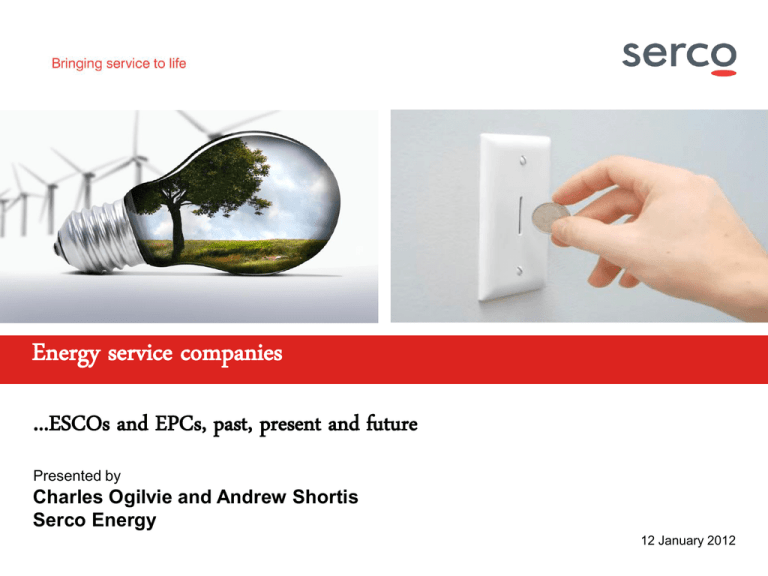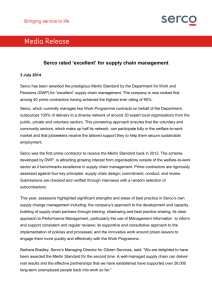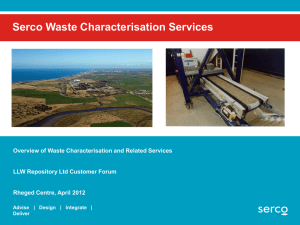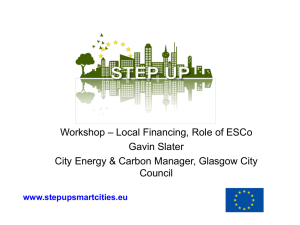120110 EPC 3 0 san (2)
advertisement

Energy service companies ...ESCOs and EPCs, past, present and future Presented by Charles Ogilvie and Andrew Shortis Serco Energy 12 January 2012 Biogs Andrew Shortis: Engineering, and management consultancy background. Former VC Experienced at delivering strategy lead growth and corporate recoveries Appointed to develop the strategy and prove a new Energy business concept Charles Ogilvie: Lead Greg Barker’s policy team in opposition Independent strategy consultant in new energy sector Joined Serco as Head of Strategy in Energy business Serco Energy Management Solutions partner with customers to deliver a phased programme of works that will not only deliver guaranteed energy demand reduction but also investigate, and where viable, integrate on-site renewable energy generation capacity. 2 Serco Internal Index Brief history Market drivers Case study Variations in the model Conclusions Public sector? 3 Serco Internal Brief history Oil shock – Time Energy Slow growth in US but model evolved – Monopoly Utilities made model more ‘stable’ – Sector specialists – By the 90s ESCO sector re-emerges in US, typified by Amaresco (2000) Pioneered in the UK and Europe in the late 80’s and 90’s – Limited by technology capability and costs – and stable low energy prices – UK turnover mainly med/large CHP and chauffage- mostly in industry – Utility competition and low energy prices meant little development of market in 1990s for smaller customers – Now ∼50 ESCOs investing £100-200m pa total annual income of ∼£1bn 4 Serco Internal US/UK sector growth ~$950m ~$700m 5 Goldman, A Survey of the U.S. ESCO Industry: Market Growth and Development from 2008 to 2011, Satchwell, Serco Internal Larsen, Gilligan, Singer- Berkeley National Laboratory, June 2010, Uk market DATA from ESTA and Sorrell 2005 Drivers Rapidly rising energy prices – ROCS etc! Pressure on Governments and private companies to reduce spending Finance looking for more market insulated investments Increasing legislative support (for efficiency, reduced CO2 emissions, encouraging renewable energy)? Lower tech costs: BEMS price down tenfold (capex/ kWh saved) Replacement of aging infrastructure 6 Serco Internal Drivers DECC forecast central price scenario for energy consumption assumes a 30% saving on energy consumption across economy by 2020 and a 40% saving by 2030- this includes transport where energy consumption will rise with electrification 350 300 BOEm 250 200 BAS@2% BAU 150 DECC projection 100 50 0 7 Serco Internal Case study: Logistics Company Reduce energy consumption and carbon emissions in UK cold stores – energy significant proportion of operating costs LED replacement lighting pilot proven substantial savings – Lower energy consumption – Less heat produced – reducing thermal load on the chillers – Switchable by sensors – saving energy in lighting and refrigeration – Longer operating life and less maintenance Potential 85% cut in lighting energy costs – better working conditions £xxxm needed to fund an initial roll-out to xx sites – then further xxx Case study: Paid from savings model Capital is invested into SPV Investor Finance Investor receives share of the energy savings achieved Special Purpose Vehicle Project Company SPV funds the implementation of the energy efficiency projects Customer SPV is paid a share of the energy savings achieved Energy costs Savings retained by customer Savings retained by investor Before project During project After project Serco Internal Case study: How this would work Share of energy savings Special Purpose Vehicle Logistics Co Equity investment Financier Investment return Energy Performance Contract Performance guarantee Procurement & installation Serco Lighting Co Serco Internal Case study: Features and benefits Investor funds full cost of the project – no Customer capital contribution Return is entirely contingent on realised energy cost savings All of the risk is with the investor delivering the service (not assets) No minimum funding payment to make – no savings, no repayment Investment can be held off-balance sheet – confirmed at outset Enhanced Capital Allowances can be paid-on to the Customer Customer have a right to purchase the assets at any time during the Energy Performance Contract (EPC) Simple, straightforward and quick realisation – 6-8 weeks Serco Internal Case study: Investment proposal Four year Energy Performance Contract (EPC) – 43% of saving comes from lower energy consumption of lamps – 13% through sensing and switching – 22% due to the lower thermal load on the chillers – 18% through lower maintenance costs and less down time – 4% from saving in Carbon credits Customer gets at least 20% energy cost savings during the EPC – and all of the energy cost savings in excess of the ROI Serco and Lighting Co make up any shortfall in the expected ROI Measurement at one site will be used to help confirm savings made At the end of the EPC, title and all the benefit transfers to Customer Serco Internal Variations in the model Full ESCO, 5+ technologies, service contract. Multi tech EPC Onsite generation with service/ fuel contract Single tech EPC EG? -voltage optimisation -EIS funded -.5-2m capex -LEDs, voltage optimisation, BEMS, AC motor retrofit -EIS/PE funded -1m+ capex -boiler plant, lighting, insulation, BEMS, draught exclusion, PV -PE, institutional funds -£2m+ capex -district heating/CHP -debt project finance -£3m+ -any -public sector? -large sites make sense -Local authorities, large estates, mid size commercials Customers? -B2B sales -aggregated small sites ? Serco Internal PROs/CONs Full ESCO, 5+ technologies, service contract. Multi tech EPC Onsite generation with service/ fuel contract Single tech EPC CON -scale aggregation -opportunity ‘lock out’ -simple savings -smaller market -solution design risk -investor comprehension -harder to control operational risk -hard to sell -buying energy -expensive development costs -blocked by incumbent FM -tech capex heavy -planning -secure fuel supply/cost -tied into utility contracts -greater access to compound savings -bigger market -full market -squeeze out all savings -operational comfort -safer revenues -established and easier to finance PRO -easy sale -low development costs -lower solution risk -differentiation Serco Internal More variations in the model – M+V – Asset ownership – Flow of funds – Risk/warranty/insurance – Accountancy treatment PLUS -Policy complexity Social housing project uses: CERT, CESP, RHI, FITs, ECAs, EIS etc – GD?! -Planning..... 15 Serco Internal EG Monitoring and Verification Description Typical Application Partially Measured Retrofit Isolation Savings are determined by partial field measurements of the energy use of the system(s) to which an ECM was applied. Some, but not all, parameters may be stipulated. Lighting retrofit where pre-and postretrofit fixture Wattages are measured. Operating hours of the lights are typically agreed upon Retrofit Isolation Savings are determined by field measurement of the energy use of the systems to which the ECM was applied. Variable speed drive on a pump. Electricity use is measured by a kWh meter installed on the electrical supply to the pump motor. Whole Facility (Utilities) Savings are determined by measuring energy use at the utility meter level. Bills may be corrected for weather. Several ECMs affecting many systems in a building. Utility Bills are used Simulation Savings are determined using building simulation. This option is rarely used, and is used primarily when there is no pre-retrofit utility data available. Multifaceted energy management program affecting many systems in a building but where no base-year data are available. 16 Serco Internal Early conclusions Sales only happen when customer and financier understand the deal More measures, more savings, harder to sell Few people have real track record, even those who say they have.. Customers spend ‘free’ money as carefully as their own Approach to risk still reflects a very immature market Every project need a good baseline but not every project needs 3rd party M+V to recognise international standards. No-one in the private sector is buying escos Selling single intervention can start to develop a relationship It’s just a deal Serco Internal What’s going to change? Finance Accept/ understand project risks Cut Tx costs and reduce cost of capital Learn to aggregate projects OEM/Suppliers Willingness to deliver wider range of solutions Recognise and squeeze out best savings Provide stronger performance guarantee Customer Awareness Learning how to buy Willingness to lose some op control EPC-ESCO 18 Serco Internal UK Trends/Forecasts Utilities – Model remains at odds with sales volume business model – Sector changing as a result of regulation OEMs – Can grow market share with balance sheet financed deals and performance warranties on their own kit – Will do well for narrower solutions and through procurement frameworks Service companies – Slow starters but no reason why they can’t perform as well as in US 19 Serco Internal How to accelerate deployment? Stimulate 25% target – government buying Accreditation for new tech/ solutions aimed at finance community Experience sharing/ best practice/ procurement advice Dampen Competing Efficiency grant schemes? GD?? Picking winners Overlooking novel tech and new entrants 20 Serco Internal Conclusions Horses for courses- but which ones and why? Utilities favour generation and full esco/chauffage model- why- sell kit and protect market share OEMs look for tech (sales) driven projects initially focussed around their offering Service Cos will make this feel like FM+ ESCOs? Consultants + finance + entrepreneurs. Will be drawn to complex solutions but initially struggle to deliver much third party funded projects outside single solutions (risk management) Serco Internal Public Sector? Shares many challenges with private sector – Understanding the solution – Lack of clear executive focus on problem – Operational concerns But enhanced by: – Restricted borrowing – but many authorities do have funds – Lack of off balance sheet certainty – solvable? – Frameworks restrict creativity – Public procurement restricts speculative project development – Procurement expertise limits speed of sale Successes: – LEEF has energised sector 22 Serco Internal










